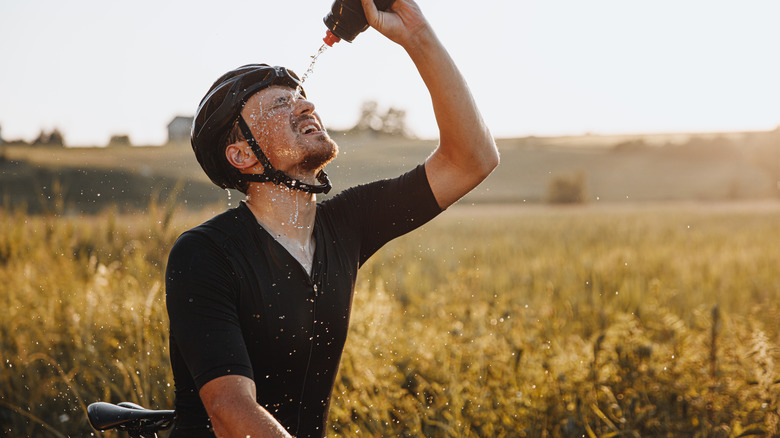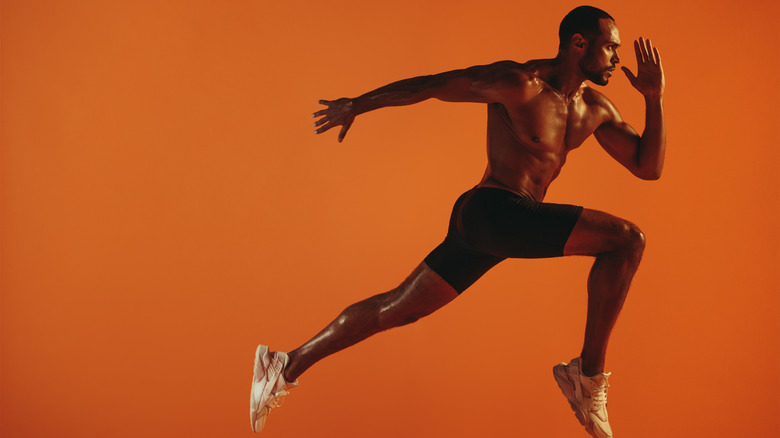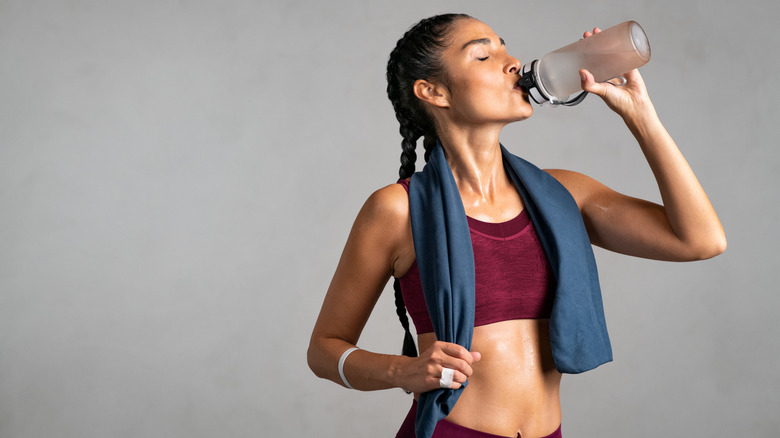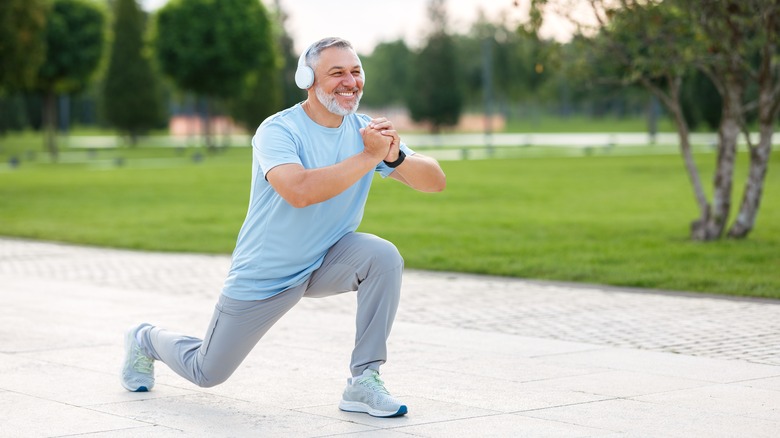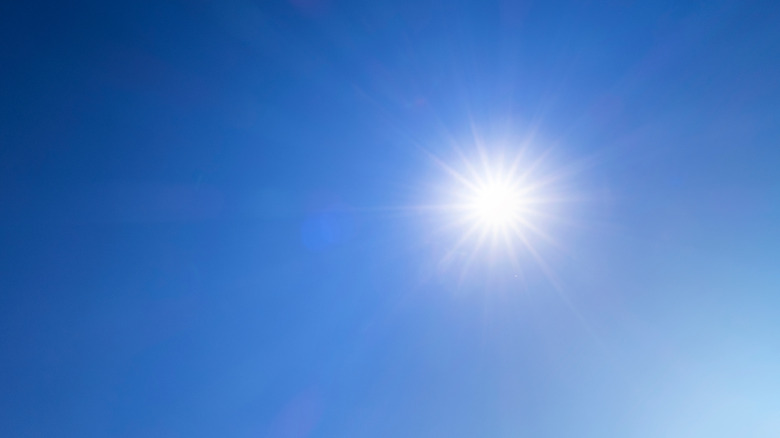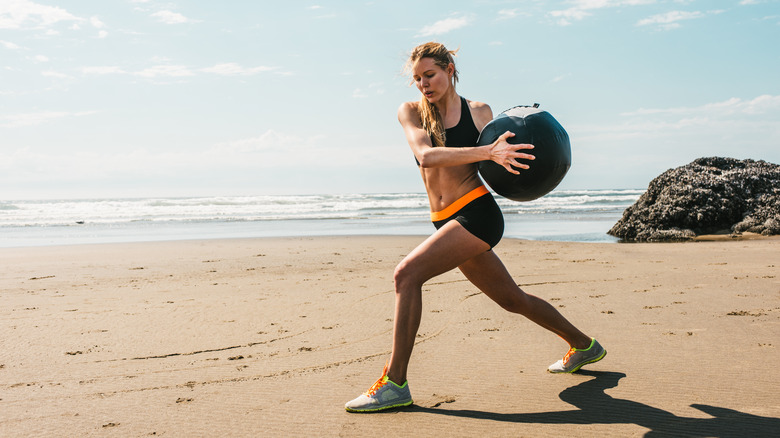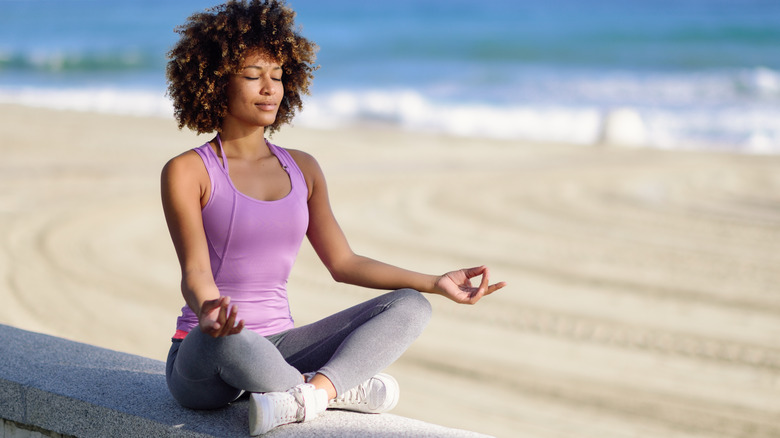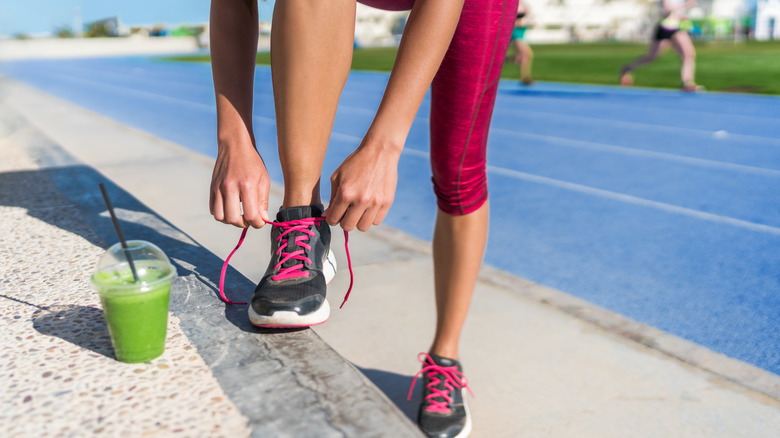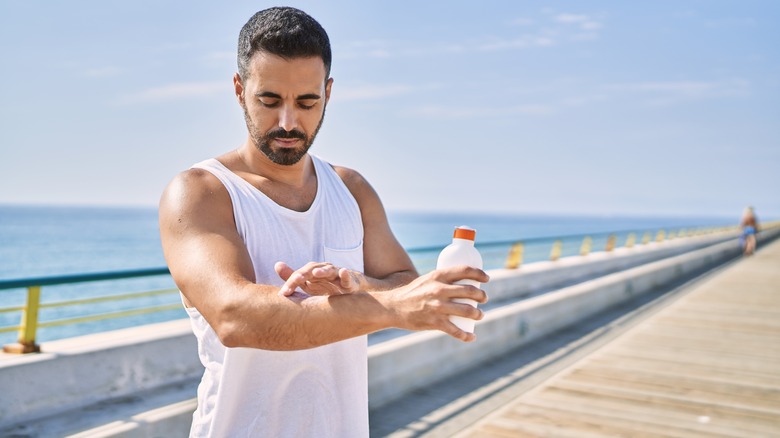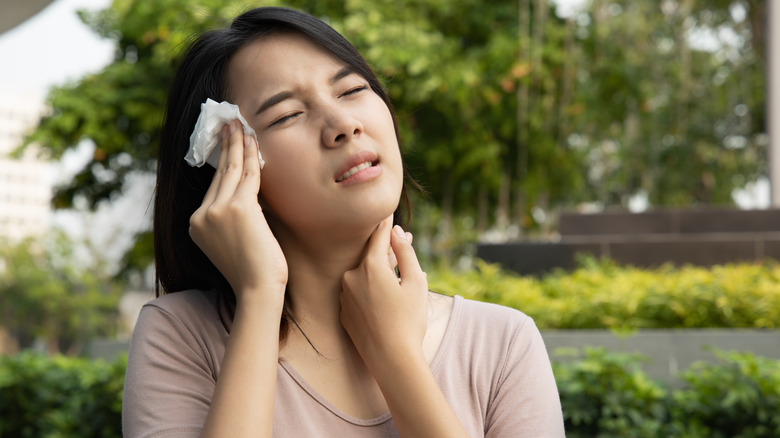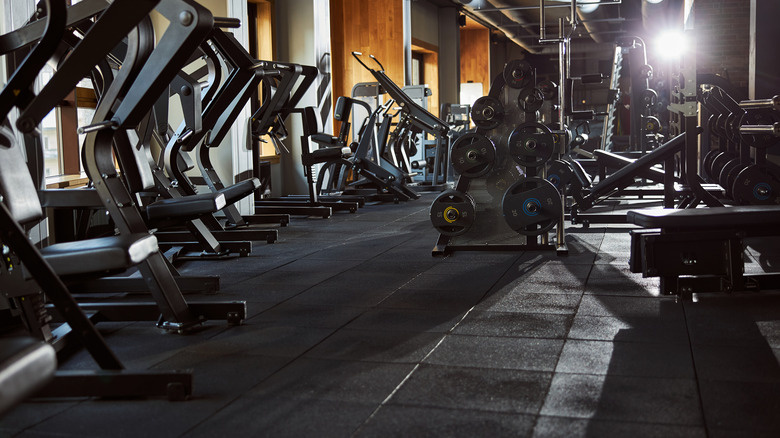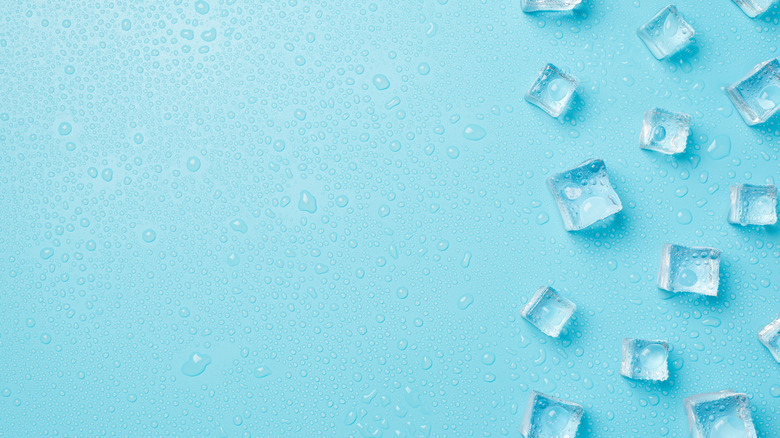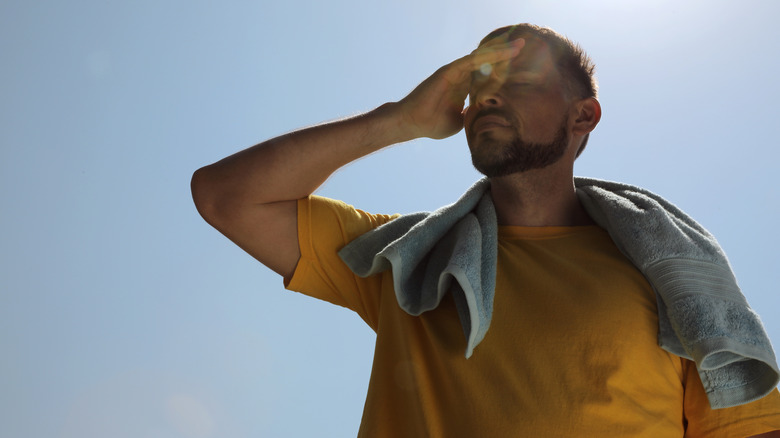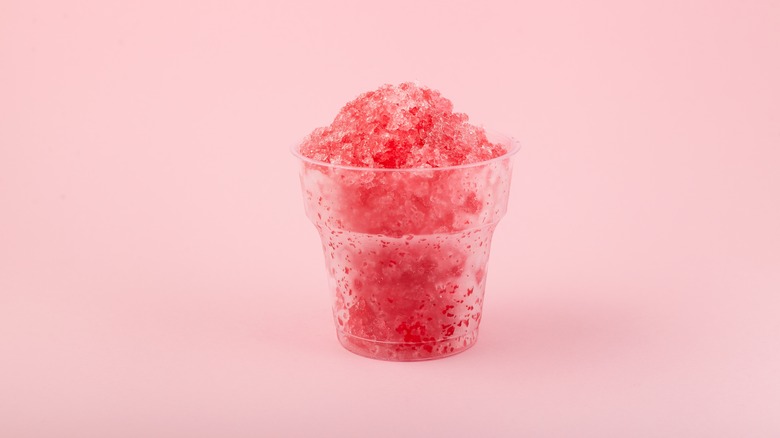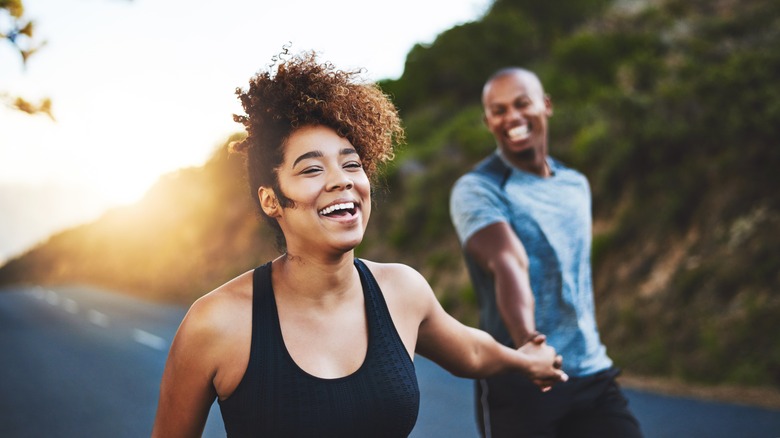14 Tips To Help You Get Through A Workout When It's Hot Out
When the mercury in the thermometer rises, people tend to fall into one of two camps workout-wise: They're either busting to get out the door and sweat, or they're filled with fear at the prospect of having to exercise in an inferno. And if you're in the latter camp, we feel your pain. Working out in the heat can be no joke, and when it's especially hot out, it can feel like you're putting your body through pure hell.
In actual fact, though, working out in the heat can be seriously beneficial for us. A study published in the International Journal of Sport Nutrition and Exercise Metabolism discusses the fact that exercising in hot climates can boost our performance in similar ways to working out at higher altitudes. And getting outside when it's roasting out might seem a chore, but being out in nature around the trees and grass will provide you with a host of mental health benefits, as research in Extreme Physiology & Medicine indicates. The question, then, is not whether or not we work out when it's hot, but how best do we do it? We've got the answers for you right here, dear readers.
Don't try to work out as hard as you would normally
The hottest day of the year presents many challenges, the first being to get through to the other side without melting into a puddle of sweat. But don't let your workout be one of the challenges. It's super important to consider the environment you're exercising in and how realistic it is that your body will be able to work at peak performance. "Exercising in hot weather puts extra strain on the body, so it's really important to know your limits, and pay close attention to your body," says personal trainer David Wiener to Harper's Bazaar. Particularly high temperatures will have an impact on your workout, and trying to combat that might just make you feel worse, Wiener says.
That's why it's especially important to lower your workout's intensity when it's hot and to exercise at a comfortable level. Make sure that if you feel faint or dizzy at any point, you're not trying to push through, and instead resting for a while or slowing down a little. If you're practicing resistance training, give yourself plenty of time between exercises and sets so that your body can cool itself off. Remember, you want your workout to be helpful, not punishing.
Make sure that you're properly hydrated
Staying hydrated when you're working out is important at the best of times, but when it's hot outside, it takes on a whole new element of importance. Dehydration occurs quicker in higher temperatures, as your body needs to sweat more to cool itself down — and when this happens, your exercise performance can be compromised, and you can experience fatigue, headaches, and cramps, according to BetterHealth.
As such, keeping on top of your hydration is key, before, during, and after your workout. While water should be adequate for shorter workouts, if you're exercising particularly intensely or working out for a longer period, consider taking a sports drink with you, says Penn Medicine. Sports drinks are specially formulated to contain electrolytes like potassium and sodium, which will help to rehydrate you faster and replace lost salts secreted through your sweat (ever wondered why your sweat tastes salty? Well, that's why, folks). Try as much as possible to avoid caffeinated beverages, which will have a diuretic effect, causing you to pee more and lose more fluids. Be careful not to overhydrate before and after exercise.
By keeping your body warmed up, you'll work out easier
So look, we get it. When it's warm outside, the last thing you normally want to do is make yourself even hotter. But if you're planning a workout in high temperatures, it may actually be beneficial to get your body up to a higher temperature, especially in the long term.
The acclimatization effect that exposing your body to higher temperatures can have, and its effects on performance, were observed in a study from the University of Birmingham. Researchers asked participants to use a sauna after exercising and examined their responses to heat and their tolerance for it at three and seven weeks. They found that after being exposed to more heat, the runners were far more able to take higher temperatures, with their core and skin temperatures remaining lower, while their ability to sweat got better. In short, this acclimatization made their bodies better equipped to handle the temperatures. With that in mind, if you're going immediately from an air-conditioned room to a scorching hot track, it might be useful to spend a little time bringing your body up to temperature first to make sure it isn't shocked by the change.
If you normally work out at midday, switch up your time
Your lunch break rolls around, and you've got an hour. More than enough time to get that run in, right? Well, if it's especially sunny outside, we would urge you to reconsider what time you're working out. "That midday sun can add as much as 20 degrees or more to the actual air temperature. You really have to be careful about that," warns Columbia University professor of movement science Carol Ewing Garber to NPR. The added heat from the sun can quickly push your body into an overheated state.
Instead, when it's the hottest period of the year, you should time your workouts to avoid the worst of it. Garber recommends shifting your workout to either end of the day: Either first thing in the morning, when the air hasn't yet heated up, or after work in the evening when the temperature has dropped. And if exercising at midday's your only option, it might be worthwhile to adapt your workout to stay out of the sun. Take shadier routes, or perform your workout under a tree, to limit the impact of the sun.
Don't assume you can do the same type of workout you always do
If you have a go-to workout that you always do, you're probably not alone. But when the weather changes, you may want to think about whether that exercise is going to be as beneficial as it usually is. Going on marathon-length runs in the heat, for example, can put your body under extended stress and give it fewer opportunities to cool off, which may not be ideal for when it's scorching out. Instead, mix it up. "Swap your long run for interval training or circuits," suggests personal trainer David Wiener to Harper's Bazaar. "This type of training will allow you more rest, so that your body can cool down and you can take on extra water."
We'd recommend, too, looking at the hot weather as an opportunity to switch things around. Trying out a different form of cardio workout can help to improve your endurance and prevent your body from plateauing, says Shape. If resistance training is more your thing, try a different workout, or use lighter weights while performing more reps.
Picking the right clothing is everything
We all know that a good workout outfit can make or break your exercise session, but this is never as true as when it's warm. The last thing you want is to head out for a run in blistering heat and realize halfway in that you've picked an outfit that weighs you down with sweat and provides poor ventilation. That's why choosing right is crucial. Opt for clothing that's made of breathable fabrics that move sweat away from your body, like nylon and polyester, instead of cotton clothes that absorb moisture, recommends NASM-certified personal trainer Nadia Ruiz via Self. Make sure, too, that your exercise gear is well-fitted and feels good, not too tight and not too loose, to reduce any discomfort you might already be feeling from the heat.
And interestingly, the color of what you choose to wear is important, too. Wearing dark clothes will only be a magnet for heat, and cause you to feel it even more. Instead, go for bright, light shades. These will better reflect the sun's rays, keeping you cooler, advises Equinox personal trainer Ligia Pineda to Self.
Be sure to time when you're eating around your workout carefully
Most people know the importance of good nutrition around exercise, to supercharge your gains and make sure your body's in top shape. But keep in mind that when it's hot outside, what you eat and when you do it becomes even more important. What can be particularly troublesome is eating just before you work out, which may spike your temperature even more. "It takes blood and energy to your gut to digest the food, and that makes more body heat — not what you want when you're already hot," advises Columbia University professor of movement science Carol Ewing Garber to NPR. Not to mention that eating and then immediately working out can be super uncomfortable and lead to heartburn and nausea (per Livestrong).
To avoid this, give yourself at least an hour after you eat before you get that workout in. And the bigger your meal, the longer you'll have to wait until you exercise, with fat and protein-heavy meals taking at least several hours to digest, Garber says (via NPR). And once you've finished your workout? Give yourself a little time to cool down before you eat. This will help ensure that the digestive process doesn't just keep you hot.
Make sure you're protecting your skin
In extreme temperatures, looking after our skin is of paramount importance. And this becomes doubly important when we're working out outside and exposing our skin to sun and heat for longer periods. As such, applying sunscreen is one the most vital things you should do before working out outdoors, says Everyday Health. Ensure that you're choosing a sunscreen that has an SPF of at least 30 and is waterproof so that you won't just sweat it off, using a sports sunscreen if possible. Prioritize placing it on your face and neck, as well as any other exposed body parts like your chest.
Bear in mind, too, that the sun doesn't just have an effect if you're outside. "Anytime there's visible light, you're exposed to some part of the electromagnetic spectrum. Growing evidence is showing that all light is important when it comes to skin damage and aging," states Louisiana State University and Tulane University Department of Dermatology associate clinical professor Deirdre Hooper via Everyday Health. So that light streaming through those gym windows? That has the potential to affect your skin too, folks.
Get familiar with different types of heat, and adjust accordingly
Anyone who's woken up on separate days, one feeling warm, crisp and dry, and the next feeling heavy, sweaty and moist, will know how to tell the difference between heat types. But when you're planning a workout, it's doubly important to key into how heat can vary. Humid conditions generally stress the body more in terms of heat, says professor of movement science Carol Ewing Garber via NPR. Your body might find it more difficult to cool down, because when the air's humid, sweat has a harder time evaporating into the air, and so sticks to your body more. That's why getting especially sweaty in humid conditions is something you should keep an eye on, as it might indicate that your body can't drop its heat properly.
But you still need to be cautious in dry heat, too. While drier conditions mean that your sweat can evaporate with more ease, keeping your body cooler, it can often be difficult to keep track of things. "Because your sweat is evaporating so quickly (and you don't have a soaked shirt) you often won't realize how much water your body has used," Garber states (via NPR). This can lead to dehydration, fast.
In extreme heat, get wet or take your workout indoors
Okay, we get it. You might see the heat outside as the perfect opportunity to sweat it out, get in touch with your body, and leave it all on the track. But when it's especially hot, it's wise to consider whether heading outside really is the best way to work out. Working out in the blazing sun can raise your risk of conditions like heatstroke or heat exhaustion (per Penn Medicine), and let's face it, it can also be really uncomfortable.
So, take things inside! Skip your long run outside, and instead head to the gym. Or, if you're not a member, try out a home workout, many of which can be done in half an hour and are a super-efficient way of getting your sweat on (per GQ). Or, swimming is often a terrific way to exercise on hot days, and what's more, it's the perfect way to regulate your body temperature (via Penn Medicine).
Carrying ice with you is a neat trick to keep yourself cool
How many times have you been in the middle of a run, miles away from home on a hot day, and wished that you could just cool down? If it's ever happened to you, you know it's a deeply unpleasant feeling. That's why this next trick is one that we're willing to bet you'll be doing all the time. Take a pair of old lightweight pantyhose and put some ice cubes in the leg, tying it off, as ex-Paralympic Games triathlete Allysa Seely does (via Self). Then, tie the pantyhose around your neck loosely, and stuff the ice cubes down into your clothes. As you work out, the ice cube will melt, leaving you cool and refreshed.
Or, if you don't have any pantyhose lying around, you can do the same with a bandana. If you're going out on a hike or a long cycle, you can also freeze your water bottle ahead of time, ensuring that you have an ice-cold drink wherever you are.
Get familiar with the signs of heat illness
Exercising in the heat can go from bracing to brutal fast. And unless you're taking good care to keep aware of the effects that the heat's having on your body, you can quickly be left with some problems. It's important to be aware of both heat exhaustion and the more dangerous heat stroke, and to make sure you're responding to both if you're experiencing them during a workout (per Healthline). Heat exhaustion happens as a result of lost salts and dehydration (especially likely during a sweaty workout), and may manifest itself through increased sweat, tiredness or dizziness, cold and clammy-to-the-touch skin, and a quicker pulse. When heat exhaustion occurs, it's vital to cool the body as quickly as possible by removing additional layers of clothing, drinking water, moving to the shade, and resting.
Heat stroke, on the other hand, can be even more worrisome. In addition to muscle cramping, heat stroke's symptoms include heated-up skin, a strong and fast heartbeat, a higher body temperature, and fainting. Again, it's vital to cool the body down, but heat stroke can also require medical intervention, so if you're especially concerned about yourself or someone else, call 911 immediately.
Consuming cold food or drink items will improve your performance
On a sweltering day, there is nothing, simply nothing, like a cold drink. And it might come as little surprise that consuming cold beverages and food items when it's hot will not only make you feel better, but will make your workout go more smoothly. And it looks as though the colder you go, the more your performance will thank you, according to a study published in Medicine & Science in Sports & Exercise. Researchers compared the effects of giving both cold water and a colder ice slushie to runners in the heat and measured how it affected their exercise. It was found that the slushies not only reduced body temperature more effectively, but they also allowed the runners to exercise for longer.
One thing that should be noted about this study, however, was that the type of slushie that was given to the athletes was formulated specifically for the test, and is not the average Slurpee that you'd pick up at the store. Bear in mind that when you're looking for a chilled drink, you want to pick one that will augment your exercise performance. Plain water or an electrolyte-imbued beverage will be your best bets (via Food Network).
Above all, listen to your body
Following advice on exercising in the heat to the letter might make your workout more comfortable, but when it comes down to it, if your body's not happy, it's not happy. That's why it's super important to be aware of what your body's telling you, says Penn Medicine. Keep checking in with yourself while you're exercising, and if you start to feel noticeably weaker or sick, stop. Pushing through might seem like a good idea, but the last thing you want is to sustain an injury or experience a heat-related illness.
It's also worth keeping in mind that you don't have to do all your exercise in one go. Try breaking up your workout into smaller chunks, which can not only help you manage in the heat but will also remove the time pressure of doing one long workout, says Livestrong. A shorter HIIT workout in the morning and a short jog at the end of the day can help you attain your workout goals without your having to endure the midday heat.

